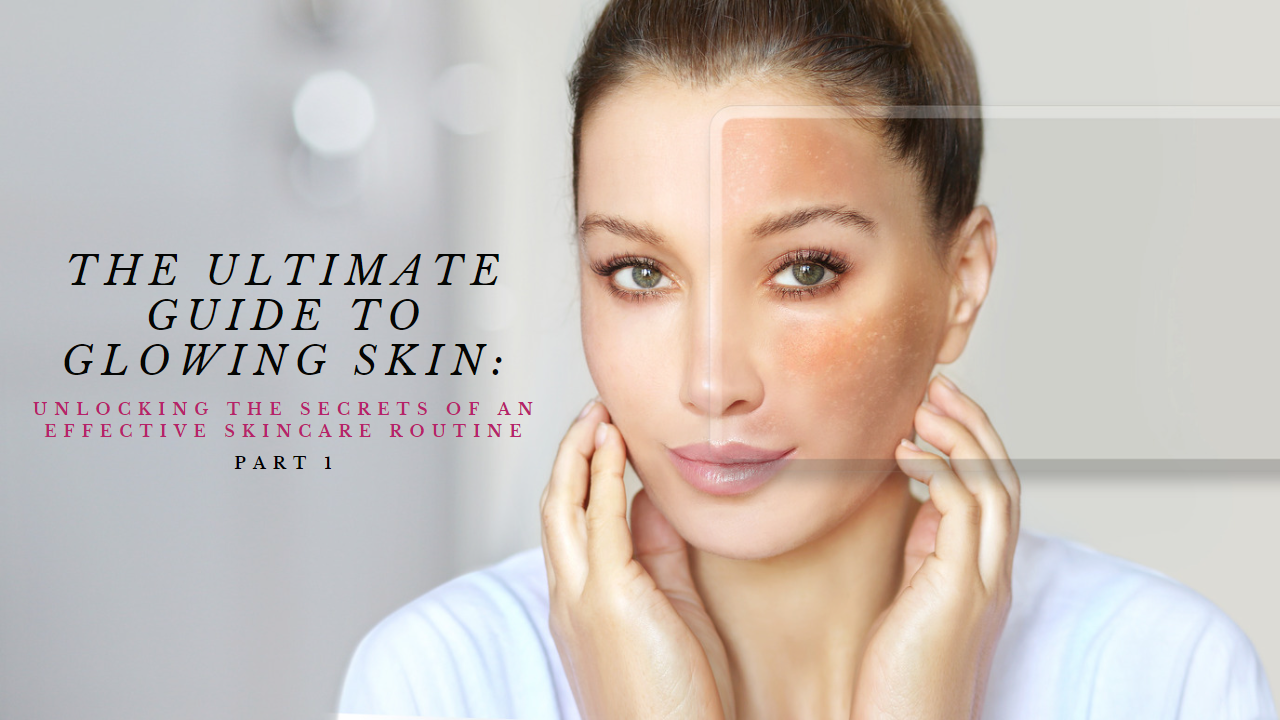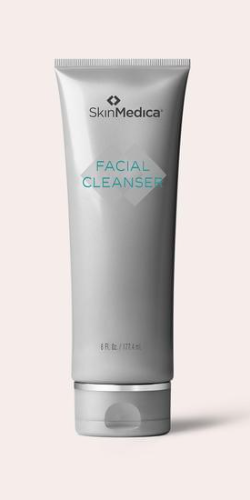Guide
Welcome to my blog series, "The Ultimate Guide to Glowing Skin: Unlocking the Secrets of an Effective Skincare Routine." In this comprehensive guide, I will delve into the skincare world and share invaluable insights to help you achieve radiant and healthy-looking skin. I have broken down this guide into four informative parts to ensure we cover all aspects thoroughly. Each segment will focus on essential components of a successful skincare routine, providing expert tips, product recommendations, and science-backed advice. Join me as we embark on this transformative journey towards achieving the skin of your dreams.
Beautiful, radiant skin is within your reach. Establishing a daily skincare routine is a self-care ritual and a pathway to achieving and maintaining healthy skin. In this comprehensive guide, we will delve into the core principles of skincare, from understanding your skin type to incorporating targeted treatments and embracing healthy lifestyle habits. Let's embark on a journey toward unlocking the secrets of a truly effective skincare routine.
For all skin types
SkinMedica’s highest customer-rated cleanser for all skin types. Removes environmental pollutants, excess oil, and makeup, and hydrates and refreshes skin.
When it comes to skincare, understanding your skin type is fundamental. Our skin is unique, and different individuals may have different skin types. Let's explore the five common skin types: normal, oily, dry, combination, and sensitive.
Normal Skin: Normal skin is well-balanced, with an even texture and minimal issues. It is neither too oily nor too dry and has tiny pores. Those with normal skin often experience fewer skin concerns and maintain a natural radiance.
Oily Skin: Oily skin produces more sebum, resulting in a shiny complexion and enlarged pores. Individuals with oily skin may be prone to acne, blackheads, and greasiness throughout the day. Proper skincare can help manage excess oil and maintain a balanced complexion.
Dry Skin: Dry skin lacks moisture and often feels tight and rough. It may appear dull, flaky, or even cracked. Those with dry skin need to focus on hydrating and nourishing the skin to restore its natural moisture barrier.
Combination Skin: Combination skin is a blend of different skin types. The T-zone (forehead, nose, and chin) tends to be oilier, while the cheeks and other areas are drier or normal. This skin type requires a balanced approach to address oily and dry areas.
Sensitive Skin: Sensitive skin is more reactive and prone to irritation and redness. It may react to certain products, environmental factors, or temperature changes. Gentle and soothing skincare products are crucial for maintaining the skin's health and reducing sensitivity.
1-STEP MULTI-CLEANSE
A luxurious, hydrating facial cleanser with Natural Prebiotics.
Determining your specific skin type is critical to tailoring your skincare routine. Here's a simple method to help you identify your skin type:
Cleanse your face: Start with a gentle cleanser to remove any makeup, dirt, or impurities.
Wait an hour: Allow your skin to return to its natural state without applying any products.
Observe your skin: Look for any signs of oiliness, dryness, tightness, or sensitivity. Pay attention to the overall texture, hydration levels, and the presence of any skin concerns.
By closely examining your skin's characteristics and behavior, you can determine your skin type and create a skincare routine that addresses your needs.
Understanding your skin type is essential for several reasons when it comes to establishing an effective skincare routine:
Targeted Products: Different skin types have distinct needs and concerns. Knowing your skin type, you can select skincare products specifically formulated to address those concerns. This ensures you provide your skin with the right ingredients and treatments it requires.
Prevention and Correction: Understanding your skin type helps identify potential problems before they escalate. It allows you to adopt preventive measures and choose products that target specific issues, such as acne, dryness, or sensitivity. By addressing these concerns proactively, you can maintain healthier skin and minimize the occurrence of future problems.
Customized Approach: Each skin type requires a tailored approach to achieve optimal results. With the knowledge of your skin type, you can customize your skincare routine, choosing the proper cleansers, moisturizers, treatments, and sunscreen that work harmoniously with your skin's characteristics. This personalized approach maximizes the effectiveness of the products and enhances your overall skincare experience.
Acne treatment cleanser that helps clear up acne blemishes.
Understanding your skin type empowers you to make informed decisions about your skincare routine. It allows you to provide the necessary care and attention your skin deserves, ensuring that your efforts yield the best possible outcomes.
When achieving healthy, radiant skin, cleansing is the first step in any skincare routine. Our skin is exposed to environmental pollutants, dirt, bacteria, and impurities throughout the day. Cleansing helps remove these external factors, excess oil, dead skin cells, and makeup residue, allowing the skin to breathe and function optimally. Here are a few reasons why cleansing is essential for maintaining healthy skin:
Removal of Impurities: Cleansing removes dirt, dust, and pollutants that accumulate on the skin's surface. If left untreated, these impurities can clog pores and lead to breakouts, dullness, and congestion.
Balancing Oil Production: Proper cleansing helps regulate oil production. A gentle cleanser can help control excess sebum for individuals with oily skin, reducing shine and minimizing the likelihood of acne. On the other hand, for those with dry skin, a hydrating cleanser helps retain moisture and prevent further dehydration.
Enhancing Product Absorption: Cleansed skin is more receptive to the benefits of other skincare products. By eliminating barriers like dirt and oil, the active ingredients in serums, moisturizers, and treatments can penetrate the skin more effectively, delivering optimal results.
Choosing a cleanser that suits your skin type is essential to maximize the benefits of cleansing. Here's a guide to selecting the right cleanser for your specific needs:
Normal Skin: Look for a gentle cleanser that maintains the skin's natural balance without stripping away moisture. Consider a mild foaming cleanser or a cream-based cleanser.
Oily Skin: Opt for a cleanser that removes excess oil and unclogs pores without leaving the skin feeling tight or dry. Foaming or gel-based cleansers with ingredients like salicylic acid or tea tree oil can be beneficial.
Dry Skin: Choose a hydrating and moisturizing cleanser that helps replenish moisture while gently cleansing. Cream or oil-based cleansers with ingredients like hyaluronic acid or glycerin are suitable choices.
Combination Skin: Consider a cleanser that balances oil production without drying out the skin. Gel or water-based cleansers work well for combination skin, as they effectively cleanse without causing excessive dryness or oiliness.
Sensitive Skin: Opt for a gentle and fragrance-free cleanser that does not irritate or disrupt the skin's barrier. Look for mild, non-foaming cleansers with soothing ingredients like aloe vera or chamomile.
Remember, patch-testing new products on a small area of your skin is essential to ensure compatibility and avoid potential allergic reactions.
For all skin types
This elegantly formulated exfoliating cleanser gently scrubs away dead skin, improving the appearance of skin tone and texture.
To get the most out of your cleansing routine, follow these proper techniques for effectively cleansing your face:
Wet your face: Splash your face with lukewarm water to prepare your skin for cleansing.
Apply cleanser: Take a small amount and gently massage it onto your damp face using upward circular motions. Be sure to cover your entire face, including the jawline, forehead, and sides of the nose.
Avoid harsh scrubbing: While it may be tempting to vigorously scrub your skin, especially if you have stubborn makeup or oily areas, it's best to avoid aggressive scrubbing. This can irritate and damage the skin's protective barrier.
Rinse thoroughly: Rinse your face with lukewarm water until all traces of the cleanser are removed. Make sure there is no residue left on your skin.
Pat dry: Gently pat your face dry with a clean, soft towel after cleansing. Avoid rubbing, as this can cause unnecessary friction and potential irritation.
Remember, cleansing should be done twice daily, in the morning and evening, to keep your skin clean and fresh. Additionally, it's essential to adapt your cleansing routine based on your individual needs and the environmental factors affecting your skin.
In Part 2, we will explore the benefits of exfoliating the skin and various methods to reveal fresh and radiant skin. I will also explain the importance of moisturizing and choosing the right moisturizer for your skin type. So, catch Part 2 in this series to learn valuable insights and tips on achieving a glowing complexion.






